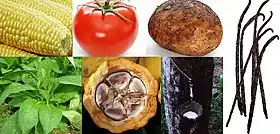New World crops
New World crops are those crops, food and otherwise, that were native to the New World (mostly the Americas) before 1492 CE and not found anywhere else at that time. Many of these crops are now grown around the world and have often become an integral part of the cuisine of various cultures in the Old World. Notable among these crops are the Three Sisters: maize, winter squash, and climbing beans.

List of crops
Timeline of cultivation
The new world developed agriculture by at least 8000 BC.[2][3][4] The following table shows when each New World crop was first domesticated.
| Date | Crops | Location |
|---|---|---|
| 8000 BCE[5] | Squash | Oaxaca, Mexico |
| 8000–5000 BCE[6] | Potato | Peruvian Andes |
| 6000–4000 BCE[7] | Peppers | Oaxaca, Mexico |
| 5700 BCE[5][8] | Maize | Guerrero, Mexico |
| 5500 BCE[9] | Peanut | South America |
| 5000 BCE[10] | Avocado | Mexico |
| c. 4200 BCE[11] | Sea-island cotton | Peru |
| 4000 BCE | Common bean | Central America |
| 3400 BCE[12] | Mexican cotton | Tehuacan Valley, Mexico |
| 3000 BCE | Sunflowers,[13] other beans | Arizona–New Mexico |
| 1500 BCE[14] | Cocoa | Mexico |
| 1500 BCE[15] | Sweet potato | Altiplano Cundiboyacense, Colombia |
| 500 BCE[16] | Tomato | Mexico |
Dissemination to the Old World
Food historian Lois Ellen Frank calls potatoes, tomatoes, corn, beans, squash, chili, cacao, and vanilla the "magic eight" ingredients that were found and used only in the Americas before 1492 and were taken by explorers and colonialists to the Old World, changing cuisine there.[17][18][19] According to Frank,[20]
If we deconstruct that these foods were inherently native, then that means that the Italians didn't have the tomato, the Irish didn't have the potato, half the British National Dish—Fish and Chips—didn't exist. The Russians didn't have the potato, nor did they have vodka from the potato. There were no chiles in any Asian cuisine anywhere in the world, nor were there any chiles in any East Indian cuisine dishes, including curries. And the French had no confection using either vanilla or chocolate. So the Old World was a completely different place.
See also
References
- Diamond, Jared (1999). Guns, Germs and Steel. W. W. Norton & Company. p. 126.
- Smith, A.F. (1994). The Tomato in America: Early History, Culture, and Cookery. University of South Carolina Press. p. 13. ISBN 1-57003-000-6.
- Hirst, K. Kris. "Plant Domestication – Table of Dates and Places". About.com. Retrieved 15 June 2016.
- Piperno, Dolores, R.; Ranere, Anthony J.; Holst, Irene; Iriarte, Jose; Dickau, Ruth (2009). "Starch grain and phytolith evidence for early ninth millennium B.P. maize from the Central Balsas River Valley, Mexico". PNAS. 106 (13): 5019–5024. Bibcode:2009PNAS..106.5019P. doi:10.1073/pnas.0812525106. PMC 2664021. PMID 19307570.
- Smith, Bruce D. (February 2001). "Documenting plant domestication: The consilience of biological and archaeological approaches". Proceedings of the National Academy of Sciences of the United States of America. 98 (4): 1324–1326. Bibcode:2001PNAS...98.1324S. doi:10.1073/pnas.98.4.1324. PMC 33375. PMID 11171946. Retrieved 4 November 2013.
- Spooner, DM; et al. (2005). "A single domestication for potato based on multilocus amplified fragment length polymorphism genotyping". PNAS. 102 (41): 14694–99. Bibcode:2005PNAS..10214694S. doi:10.1073/pnas.0507400102. PMC 1253605. PMID 16203994.
- Perry, Linda; Kent V. Flannery (July 17, 2007). "Precolumbian use of chili peppers in the Valley of Oaxaca, Mexico". Proceedings of the National Academy of Sciences of the United States of America. 104 (29): 11905–11909. Bibcode:2007PNAS..10411905P. doi:10.1073/pnas.0704936104. PMC 1924538. PMID 17620613. Retrieved 4 November 2013.
- Ranere, Anthony J.; Dolores R. Piper; Irene Holst; Ruth Dickau; José Iriarte (January 23, 2009). "The cultural and chronological context of early Holocene maize and squash domestication in the Central Balsas River Valley, Mexico". Proceedings of the National Academy of Sciences of the United States of America. 106 (13): 5014–5018. Bibcode:2009PNAS..106.5014R. doi:10.1073/pnas.0812590106. PMC 2664064. PMID 19307573. Retrieved 4 November 2013.
- "Earliest-Known Evidence Of Peanut, Cotton And Squash Farming Found". Science Daily. June 29, 2007. Retrieved 4 November 2013.
- Galindo-Tovar, María Elena; Arzate-Fernández, Amaury M.; Ogata-Aguilar, Nisao & Landero-Torres, Ivonne (2007). "The avocado (Persea americana, Lauraceae) crop in Mesoamerica: 10,000 years of history" (PDF). Harvard Papers in Botany. 12 (2): 325–334, page 325. doi:10.3100/1043-4534(2007)12[325:TAPALC]2.0.CO;2. JSTOR 41761865. Archived (PDF) from the original on 10 October 2015.
- Rajpal, Vijay Rani (2016). Gene Pool Diversity and Crop Improvement, Volume 1. Springer. p. 117. ISBN 978-3-319-27096-8. Retrieved 9 April 2016.
- "The Domestication History of Cotton". Retrieved 21 August 2017.
- Kent, J.A.; Bommaraju, T.V.; Barnicki, S.D. (2017). Handbook of Industrial Chemistry and Biotechnology. Springer International Publishing. p. 902. ISBN 978-3-319-52287-6. Retrieved August 4, 2020.
Sunflower Seed Sunflower (Helianthus annus var. marcocarpus) is a New World crop, known to have been grown in Arizona–New Mexico in 3000 BC and in the Mississippi–Missouri Basin at least since 900 BC.
- "History of Chocolate Timeline – Origin of Chocolate". thenibble.com.
- García, Jorge Luis. 2012. The Foods and crops of the Muisca: a dietary reconstruction of the intermediate chiefdoms of Bogotá (Bacatá) and Tunja (Hunza), Colombia (M.A.), 1–201. University of Central Florida.
- Smith, A. F. (1994). The Tomato in America: Early History, Culture, and Cookery. Columbia SC, US: University of South Carolina Press. ISBN 978-1-57003-000-0.
- Babb, Robin (May 22, 2019). "The 'Nativore' Chef Working to Improve Nutrition in Indigenous Communities". Civil Eats. Retrieved June 7, 2019.
- "Rediscovering Native American cuisine before it gets lost". Food Management. January 2, 2019. Retrieved July 27, 2019.
- Gomez, Adrian (August 16, 2019). "Red Mesa Cuisine owner aims to bring 'ancestral foods back to the table'". www.abqjournal.com. Retrieved November 3, 2019.
- Kunz, Jenna (July 31, 2019). "The Chef Revitalizing Native American Cuisine". Unearth Women. Retrieved October 11, 2019.